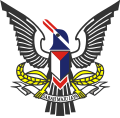 | - Description
- From 1 January 1982 until 15 September 1988, the coat of arms of Sabah was a kingfisher. [4] The Sabah state government chose to adopt a state coat of arms that resembled Sarawak's hornbill, in memory of the two Borneo states' common history as vassal states of Brunei in the pre-British times. The kingfisher was adopted because of its indigenous Bajau sea gypsies (who ancestrally hail from the Southern Philippines since their original homelands of Sulu-Mindanao are strategically close to this Malaysian state), were once politically powerful in the state administration from independence in 1963 until the rise of the United Sabah Party government in 1986, along with ethnic Bruneian Malays who are originally from Brunei in which they constitute the two largest Muslim Bumiputera ethnicities of this Malaysian state in Borneo, identify with this bird to a great extent. Both of these indigenous groups were traditionally fishermen and amongst Borneo natives, birds are considered messengers of the gods. The omen bird for the fishermen is the kingfisher. The majority native tribe, the interior-dwelling Kadazans or Dusuns, identify with the kingfisher to a lesser extent, as the bird is commonly found amongst their main occupational group, the rice farmers. [5] The exclusion of Mount Kinabalu from the coat of arms at that time did not enjoy support from majority of the Sabah populace. [6] [7]
- Years in use
- 1982–1988
- Escutcheon
- Tierced per pall, gules, argent and azure.
- Supporters
- A Kingfisher proper displayed, clutching a scroll of state motto.
- Motto
- Sabah Maju Jaya
(Let Sabah Prosper) - Other elements
- Two mirroring paddy plants (15 grains each)
|






